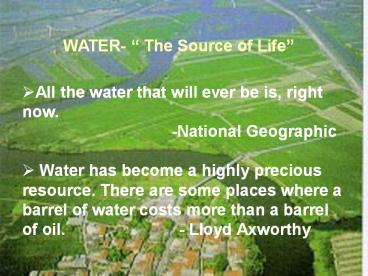What is Watershed. - PowerPoint PPT Presentation
Title:
What is Watershed.
Description:
WATER- The Source of Life All the water that will ever be is, right now. -National Geographic Water has become a highly precious resource. – PowerPoint PPT presentation
Number of Views:1659
Avg rating:3.0/5.0
Title: What is Watershed.
1
WATER- The Source of Life
- All the water that will ever be is, right now.
- -National
Geographic - Water has become a highly precious resource.
There are some places where a barrel of water
costs more than a barrel of oil.
- Lloyd Axworthy
2
WHAT IS WATERSHED
- A watershed is a basin like landform defined by
peaks which are connected by ridges that descend
into lower elevations and small valleys. - It carries rainwater falling on it drop by drop
and channels it into soil, rivulets and streams
flowing into large rivers and in due course sea. - It affects the people living downstreamof
- It is a synonym of catchment or basin of a river
coined for an area restricted to 2000sq. Km.
3
CHARACTERISTICS OF WATERSHEDS
- All characteristics affect the disposal of water.
- SIZE It helps in computing parameters like
precipitation received, retained, drained off. - SHAPE Different shapes based on morphological
parameters like geology and structure, eg. pear,
elongated etc. - PHISIOGRAPHY Lands altitude and physical
disposition. - SLOPE It controls the rainfall distribution and
movement - CLIMATE It decides the quantitative approach.
- DRAINAGE It determines the flow characteristics
and so the erosion behavior.
4
CHARACTERISTICS OF WATERSHEDS
- VEGETATION Information of species gives a sure
ground for selection plants and crops. - GEOLOGY AND SOILS Their nature determines size,
shape, physiographic, drainage and groundwater
conditions. Soils, derivative of rocks are the
basic to greenery - HYDROLOGY Basic to final goal of growing
greenery in a watershed. It helps in
quantification of water available. - HYDROGEOLOGY Availability of groundwater.
- SOCIOECONOMICS Statistics on people and their
health, hygiene, wants and wishes are important
in managing water.
5
- ADVANTAGES OF WATERSHED APPROACH
- ENVIRONMENTAL FRIENDLY
- SAVES TIME AND MONEY
- GREATER PEOPLES PARTICIPATION
6
- WATERSHEDSHED MANAGEMENT
- It involves management of land, water, energy and
greenery integrating all the relevant approaches
appropriate to socioeconomic background for a
pragmatic development of a watershed - Greening of the watershed through proper
management of land water and energy resource.
7
The objectives of watershed management
- Conserving soil and water
- Improving the ability of land to hold water
- Rainwater harvesting and recharging
- Growing greenery trees, crops and grasses
8
soil conservation techniques
- Contour
- Gully control
- Reclamation of alkaline soil
- Green carpeting
9
- contour
gully
contour
Green carpeting
10
Rainwater harvesting and recharging
- Capturing runoff from rooftops
- Capturing runoff from local catchments
- Capturing seasonal floodwaters from local streams
- Conserving water through watershed management
11
Components of rainwater harvesting
- Catchments
- Coarse mesh
- Conduits
- Storage facility
12
Rainwater harvesting in a house
13
Rain water harvesting in a village
14
Rain water recharging
15
Rainwater harvesting through recharge well
16
These techniques can serve the following
purposes
- Provide drinking water
- Provide irrigation water
- Increase groundwater recharge
- Reduce storm water discharges, urban floods and
overloading of sewage treatment plants - Reduce seawater ingress in coastal areas.
17
How much water can be harvested?
- Urban scenario
- Water harvesting potential Rainfall (mm) x
Collection efficiency - Area of plot 100 sq. m. (120 square yards)
- Height of the rainfall 0.6 m (600 mm or 24
inches) - Volume of rainfall over the plot Area of plot x
height of rainfall - Assuming that only 60 per cent of the total
rainfall is effectively harvested - Volume of water harvested 36,000 litres (60,000
litres x 0.6) - This volume is about twice the annual
drinking water requirement of a 5-member family.
The average daily drinking water requirement per
person is 10 litres.
18
Rural scenario
- India's average rainfall is about 1170 mm.
- An average indian village needs 1.12 hectares of
land to capture 6.57 million litres of water - India's total land area is over 300 million
hectares. Let us assume that India's 587,000
villages can harvest the runoff from 200 million
hectares of land, excluding inaccessible forest
areas, high mountains and other uninhabited
terrains, that still gives every village on
average access to 340 hectares or a rainfall
endowment of 3.75 billion litres of water. - These calculations show the potential of
rainwater harvesting is enormous and undeniable.
19
Greenery
- Dry land agriculture
- Irrigation
- Forestry
- Horticulture
- Pastures and silvipastures
20
Integrated multidisciplinary approach
- Protect natural resources
- Attain good yields
- Coordinate the man power with limited funds
- Community participation
21
Presented By
- 24 NIMISH KUMAR
- 25 MEGHA SINHA
- 43 SANJEEV MOHAPATRA
- 61 DEEPAK KUMAR

